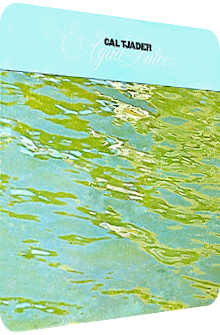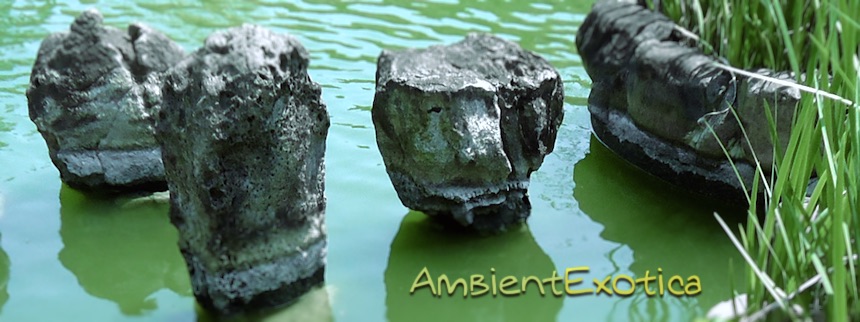
Cal Tjader
Agua Dulce
1971
The Fantasy label is the rightful home of vibraphonist Cal Tjader (1925–1982) who has released the vast majority of his latter discography on this very label, but you know the saying, a name is just a name, and once it is uttered many times, it loses its meaning and becomes commonplace. But here the label’s name perfectly fits as Tjader hands in a liquedous masterpiece of Fusion Jazz spiced with Space-Age and Exotica pericarps. Agua Dulce is that artifact of affection, named after the Bolivian canton.
Released in 1971, spawning nine tracks in total – one of them a unique piece by Tjader – and comprising the talent of 13 musicians, the big band doesn’t shy away from using electronic devices to underline the magic of the vibraphone and augment the aqualung zoetrope. These devices are not gimmicky at all but underline the brass layers and bongo beats perfectly. Among the personnel are trumpeters Frank Snow and Pat Houston, vocalists and drummers Coke & Pete Escovedo as well as Moog synthesist Rita Dowling and Fender Rhodes pianist Al Zulaica. Even though Agua Dulce sounds like a mess from the outset snce it serrates Afro-Cuban elements with Space-Age wisps and, heck, even New Age timbres, the result is definitely tempting. Read more about the timeless fusion of Agua Dulce below.
The opening spot is reserved for the eponymous title track which encounters a significant addendum and becomes known as Agua Dulce (Cool-Ade), originally composed by Johnny & Shuggie Otis and Preston Love. Aquatic splashes of the saccharified kind greet the listener who joins the fun when the recording session is already running. This in medias res approach boosts both the liveliness and immediacy. The guiro is already rasping decortications into the chant-filled vibraphone glaze, Rita Dowling’s cosmic Moog synthesizer exudes its dark matter coils, the brass section unfurls dirty horns amid the galactic cesspool. The Escovedo Bros. underline their chants with their very own timbales, Jim McCabe’s electric bass rounds off the labyrinthine fundament. The title track is supercharged with textures and movements, curiously dun-colored and hazy despite the pristine clarity of the drums and electronic instruments. It is as if the aura is purposefully limewashed. And this impression persists… but doesn’t harm the album one bit, I must add!
Cal Tjader’s own Curaçao appears, a critter of five and a half minutes that is close to the jungle, resembling the viridian/green waves of the front artwork and the titular liquor. The bandleader’s sun-dappled vibraphone contains enough contemplative tones to make it a bluesy piece alright. Siren-like background singers, Tjader’s trademark pointillism in the middle section, sizzling cymbals and Al Zulaica’s plinking Fender Rhodes piano inject a crystalline clarity that is yet again made fuzzy and dreamy due to the sustained reverb of the mallet instrument. While Billy May’s Somewhere In The Night is one of Tjader’s gorgeously soothing arrangements that exude anything but the peaceful moonlight in a very orderly, streamlined and mellow epithelium of mellifluousness, Mick Jagger’s and Keith Richards’ Gimme Shelter is a spacy journey to faraway galaxies of caproic coruscation, uniting the Space-Age genre with Exotica. Theremin-like Moog oscillations, fast tempos, icy veils and wah-wah guitars enshrine Tjader’s vibraphone and make an epiphany out of an already catchy Rock track.
Side B launches with Tito Puente’s Ran Kan Kan, an obvious Can Can interpretation that stays close to the original, but is obviously much more scintillating due to the vibraphone cascades which, in tandem with the glacial electric piano, make an icicle out of a tropical arrangement… quite a metamorphosis! The timbales, guiros and cowbells provide the bosky base, or else the polyhedric sapphire-like illuminations would outglow the earthen rhizomes and uplifting chants. Osvaldo Estivill’s Descarga Cubana then shuttles between Crime Jazz-inspired cocktail lounge vibes, sleazy basslines, Latin polyphony and maraca-heavy percussion aortas, all the while Bronislaw Kaper’s Invitation is another superiorly dreamy masterpiece of languor. It has been featured on many of Tjader’s albums and was first introduced on Latin Kick (1956). The version on Agua Dulce however basks in lactalbumin: the mixed choir is intensely luring, the evoked antrum feels like a New Age sanctuary, the vibes retroject glaucous colors.
The best tune of side B for sure! Whereas David MacKay’s Now features the same mixed choir in a brass-heavy, sun-laden diorama with eminently catchy sparks and lots of tones in major, Douglas Clare Fischer’s gold standard Morning is the hammock-compatible apotheosis, very hazy, as if perceived from a distance. The character is nevertheless festive, since the brass layers are more streamlined. A wonderfully polyfoil outro.
Agua Dulce lives up to its own title and front artwork, even though the latter is obviously no masterpiece per se, as it is all too easily accomplished. The range of colors, the fir-green hue and cyan tint are perfectly transferred into music. While the tropics are always nearby due to the Latin instruments and Cuban chants, many of the arrangements sound refreshing, others even go so far as to evoke a thin layer of hoarfrost! Agua Dulce is by no means a pluvial record; its superfluids are of a different nature. Sometimes based on nutritious cataracts, at other times depicting channels of high-energy hydrazine before venturing to mucoid potassium puddles, Cal Tjader’s album is unapologetically accessible, leaving the more convoluted Jazz roots behind – just like Solar Heat (1968) – in order to enchant with an array of melodies that are open to scrutiny.
The abundance of texture might occasionally seem overly sumptuous. After all, less is more. But here the cosmic Fender Rhodes pianos and Moog synthesizers add that certain something to the vibraphonist’s band. The benthic floralcy of Agua Dulce is hard to elbow away, its chants and exotic currents are too tempting. Fans of Tjader’s eclectic albums might be disappointed but Space-Age/Exotica fans should not resist: the album sits right in-between these two styles and is easily available on vinyl, CD, digital download and subscription services.
Exotica Review 421: Cal Tjader – Agua Dulce (1971). Originally published on Mar. 21, 2015 at AmbientExotica.com.
